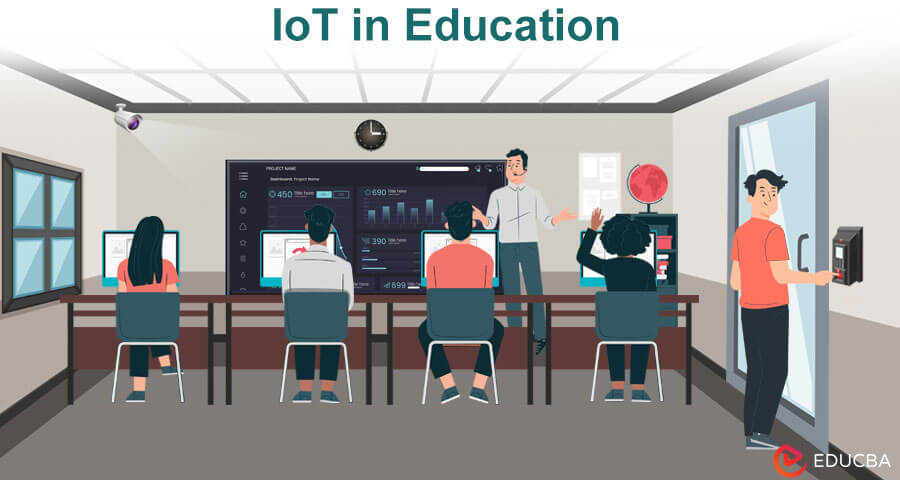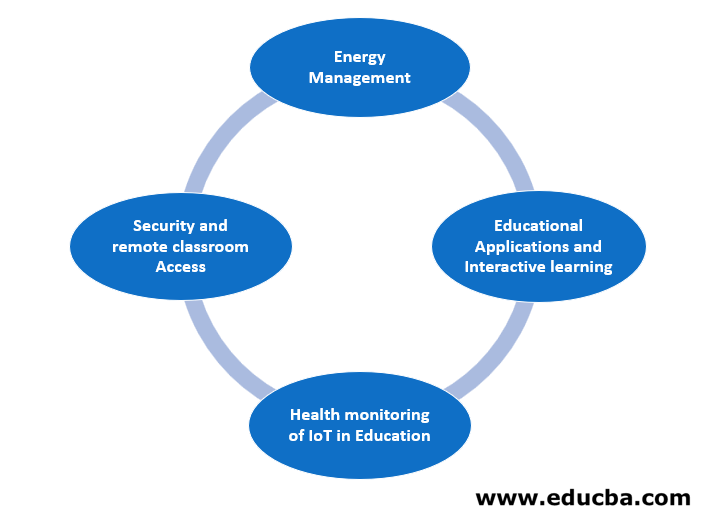Updated August 9, 2023
Introduction of IoT in Education
Internet of Things (IoT) has impacted the educational institution strongly. Education institutions are opting for the IoT ecosystem and utilizing various techniques ranging from augmented reality to cloud computing. With the integration of IoT technology, physical environments are turning smarter and more interconnected than ever. When discussing IoT in education, one might imagine things like an advanced smart classroom, digital board, and voice-based command system.
However, IoT has progressed much further and can be utilized to keep the parents updated regarding the pickup and drop of their kids, smart security cameras in the school premises, automated tracking of student attendance and much more can be accomplished within the IoT ecosystem.
Role of IoT in Education
- With the advancement in technology, our next generation is already addicted to the internet and information on demand. The major question arises, will IoT in the education system have a positive or negative effect on students. Many challenges such as privacy and additional cost of technology in education are currently being studied. Many educational institutes are still reluctant to accept IoT and are finding a better fit for it in the system. IoT in education can be broadly classified into student’s and staff’s perspectives.
- From the staff perspective, IoT has the potential to manage the class attendance of the students and the availability of the necessary educational equipment. Installing the IoT sensors in multiple locations within the educational system such as the library, cafeteria, and entrance helps in tracking and monitoring the student’s activity at different locations.
- With IoT incorporated in the classrooms, instructors can manage classrooms remotely with voice or gesture commands, establish communication with students from remote locations, collect valuable feedback from the students on a particular subject and assist specially-abled students. Other scenarios include the usage of noise sensors to communicate with neighboring classrooms and advise them on lowering the noise level.
- During an examination, IoT embedded LCD screen can detect excess noise in a particular classroom and display warning messages. Events such as the annual day or sports day registration can be easily managed with the help of the IoT ecosystem.
- IoT can help students communicate with classmates locally or remotely, exchange project information, analyze and annotate the learning material in real-time, and remotely access learning tools such as remote laboratories.
- IoT is an Internet technology sub-category that facilitates learning in many respects. IoT systems make it easier for educational institutions to gather large amounts of data from sensors and wearable devices and to carry out practical actions based on such data. By using embedded sensors, QR codes and other technologies, these systems allow students to explore and access learning materials and other information at any time.
- To boost teaching and learning, teachers can also use wearable devices and smartphones in classrooms. A smart classroom can be described as a smart environment with various types of software and hardware modules. Video projectors, sensors, and facial recognition algorithms are a few of the examples of IoT embedded ecosystem.
Applications of IoT in the Educational Sector
IoT plays a vital role in transforming the traditional educational system. There is a wide range of IoT applications in the educational sector. Let’s see a few of the areas in the educational sector where IoT can be applied.
1. Energy Management
Internet of things can be utilized for energy management by installing IoT sensors in lights and water taps. IoT based organization claims IoT solutions can help in creating a green campus by cutting down C02 emission. IoT can help campus monitor their energy consumption and make sure energy is used efficiently with the help of the smart grid. With the IoT ecosystem, energy and water usage are controlled and monitored thus establishing a healthy teaching atmosphere.
2. Security and remote classroom Access
One of the major concerns of an educational system which is creating a safe and secure atmosphere for students can be achieved by opting for the IoT ecosystem. Embedded technologies such as NFC can be utilized to manage students and their access to various parts of the campus such as laboratories and other places within the educational institute. A real-time classroom control mechanism can be developed with the help of NFC which can deliver classroom registration information and display the status of the classroom on LCD panels. Additionally, the student’s attendance can be recorded with the help of RFID tags embedded in every student’s ID card.
3. Health monitoring of IoT in Education
With the help of wearable devices, student’s health can be regularly monitored and can detect physiological signals over time. With the help of IoT, signs of depression and suicidal intentions can be detected in students and thus giving enough time for preventing any tragedy.
The system further considers individual student’s health information such as their medical history, blood pressure, and prescription to detect any signs of depleting health and inform the staff and their parents on the mobile application by raising an alarm.
4. Educational Applications and Interactive learning
Educational apps facilitate customization and allow students to decide their course of action in the way subject knowledge is delivered. From home computers to televisions students can access educational live contents on multiple channels when on sick leave. Certain applications can be utilized to create a 3D graphical textbook that features video content along with notes. Taking notes is no longer writing down on a piece of paper, with the advancement in IoT students can read out loud and voice-based application converts the speech to text and saves them in the digital notebook.
Conclusion
- In this article, we have seen multiple applications of IoT in the education sector and have discussed various benefits students and instructors are getting out of the IoT embedded ecosystem. By integrating sensors and mobile devices into the building, IoT has the potential to transform the classrooms.
- IoT has created a unique opportunity for enhanced student engagement, teaching and learning cooperation. In the near future, the Internet of Things will be incorporated into most of the education system.
- Some schools may use it to train their students for high-tech literacy, while others may use it to leverage information, save money, and other specific needs. If we want to integrate IoT into education, our understanding of education must shift to a greater perspective.
Recommended Articles
This is a guide to IoT in Education. Here we discuss the role of IoT in education, the application of IoT in the Educational Sector. You can also go through our other suggested articles to learn more–


